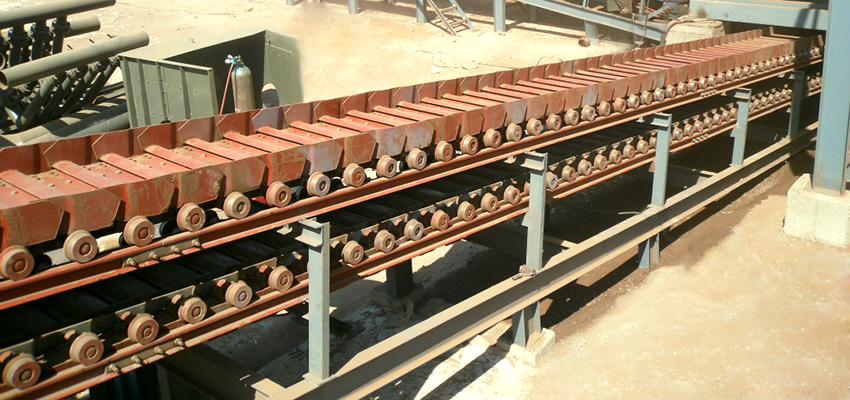The
pan conveyor is a device for conveying materials horizontally or obliquely according to the hopper running along the guideways.
Pan conveyor widely used in the transportation of various loose materials in power station, mine, coal and other industries, such as boiler ash, cement clinker, slag, coke, gravel, etc., especially some materials with high temperature, large capacity, lump block, sharp angles and hard abrasion.

(一) Working Principle
The working principle of the
pan conveyor is to use the cam force of the head section to drag the plate chain and the chain bucket along the two tracks forward, and the slag ash residue continuously flows into the slag. The cooling ash continuously is transported to the slag warehouse to realize continuous and uniform quantitative transportation of ash and slag.
(二)Structure
The
pan conveyor is mainly composed of upper and lower rail, chain bucket, chain, driving sprocket device and the others.
The chain link is a load-bearing traction member of the
pan conveyor, which is composed of a chain plate, carrier roller, inner chain plate, outer chain plate, connecting rod, bushing, pin shaft and a retention pin.
The driving wheel device is composed of a driving sprocket, axle, bearing, etc., and the driving sprocket drives the driven sprocket, so the driving wheel device is a power input device. The driven wheel device is composed of driven sprocket, axle, bearing mechanism and the others.
The driving device is composed of motor, reducer, roller chain transmission device, roller sprocket, cover, and etc.
The driving device of the
pan conveyor is composed of a stepless transmission, speed reducer, driving device frame, large sprocket, small sprocket and transmission chain. The sprockets and transmission chain should be placed in the fully enclosed protective cover. The motor and speed reducer should meet the requirements of rainproof and dustproof. The equal-pole is not lower than IP54, and the insulation class is F-class. The motor can start at 85-100% of the rated voltage and power and can accelerate the equipment that is started. The motor adopts a stepless transmission.
The structure of the
pan conveyor meets the requirements of the maximum load and the changing load. The body of the
pan conveyor is provided with a sealed inspection hole to observe the operation of the equipment and replace parts; the cleaning door is set on the head, it can be periodically opened to remove residual material from its dead ends.
The
pan conveyor chain tensioning device is convenient to adjust, the equipment can adapt to the change of material thickness, the conveying chain tensioning device adopts automatic tensioning device, the tension is constant, and the tensioning stroke is composed of two tail wheels, one tail wheel shaft and a pair of tensioning screws and compression springs.
(三) The Existing Problems
A part of the slag falls from the head to the bottom of the lower bucket, and the ash that falls down falls from the two chain plates to the return chain and the tail section.
From the beginning of production, it has been the case that two workers are employed in each shift to carry out regular slag cleaning at the tail. The slag cleaning workload is very large, and environmental pollution is also caused, and the manual cost is not low every month.
(四)Solution
After conducted many tests in the early stage, although it has changed a lot, there is still not very ideal. Through careful observation, a solution had been found, if the slag is blocked at the tail which not allowed to come out, then the slag brought back will be taken away. Therefore, a steel plate is placed at the tail of the
pan conveyor to block the ash. After observing the amount of slag brought back, calculate a 30*30 angle steel every 15-30 chain, which will satisfy all the slag scrape back into the conveyor.
This kind of transformation is actually very simple, but it solves the problem that the
pan conveyor has more than one year of slag. After the completion of the transformation, the effect is very satisfactory. It has been used for more than a year, and no one has been hired to carry out the slag.





